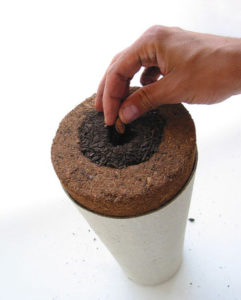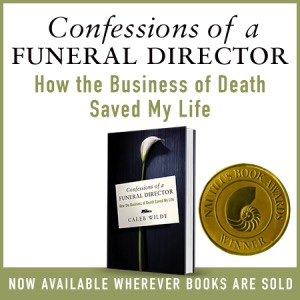Disposition
Would You Consider a Green Burial?
Seventy-five years from now it’s very possible that Green Burials will replace embalming as “the traditional mode of disposition.” The environmental friendliness of green burials is one reason (not to mention the DIY spirit behind it) why I believe Americans may start to trend towards this mode.
The following is an older article from Apartment Therapy (that I found via a link from Connecting Directors) that provides some of the environmental reasoning behind green burials:

Scientific American says it well: “Modern western-world burial practices are arguably absurd, all things considered: We pack our dearly departed with synthetic preservatives and encase them in impenetrable coffins meant to defy the natural forces of decomposition that have been turning ashes to ashes and dust to dust for eons.”
Along with this, shall we call it, denial, there is a tremendous amount of waste in modern burials, at least in America.
According to National Geographic,
“American funerals are responsible each year for the felling of 30 million board feet of casket wood (some of which comes from tropical hardwoods), 90,000 tons of steel, 1.6 million tons of concrete for burial vaults, and 800,000 gallons of embalming fluid. Even cremation is an environmental horror story, with the incineration process emitting many a noxious substance, including dioxin, hydrochloric acid, sulfur dioxide, and climate-changing carbon dioxide.”
That’s heartbreaking. Death is hard enough to contemplate, but the last thing I want to do after I’m gone is make the world worse for everyone else still here. Sure, I’ve loved trees and steel and concrete in this life, but I certainly don’t need them once I’ve passed away. You guys enjoy them! And after trying so hard to be a good person, I really don’t want my final contribution to the world to be a noxious substance.
So, what to do? Scientific American lists a few options, including sustainably-harvested more-biodegradable coffins, trees instead of headstones, dry ice instead of embalming fluid, and specially-designed urns that can become part of ocean reefs.
The Huffington Post likewise lists horrifying statistics (formaldehyde causes cancer and prevents a corpse from “decomposing efficiently, and this slow rotting process favors sulfur-loving bacteria, which can harm nearby water sources”) and better, more affordable alternatives.
Two that caught my eye were a new technology that can turn a corpse into compost, and a bicycle hearse. Design Taxi featured Martín Azúa’s Bios Urn (shown above), a biodegradable urn that holds ashes and the tree seed of your choice (although keep in mind that according to the Huffington Post, “the energy used to cremate one body is equivalent to driving 4,800 miles”).
*****
Ignoring the acerbic language and tone of the article, would you consider a green burial?
How Funeral Taboo Are You?
Answer these questions with a “yes” or “no”. If you answer all “yes”, you are 100% funeral taboo … in other words, you’re willing to try funeralization practices that aren’t generally accepted by society.
With each “no” your taboo goes down 10%.
(NOTE: these questions assume a disposition of burial)
1. Do you want to be buried/cremated in something other than dress clothes?
2. Does a house funeral appeal to you?
3. Would you like your pet to attend your funeral?
4. Are you more likely to spend money on a funeral meal than funeral merchandise?
5. Is burial in a traditional cemetery unappealing to you?
6. Would you rather have your funeral ceremony be more extemporaneous than structured … less preacher centered and more sharing centered?
7. Does having a photographer and/or videographer at a funeral appeal to you?
8. Do you want to incorporate aspects of a green funeral into your funeral?
9. Are you familiar with words like “Ecoffin” and “Ecopod“?
10. Have you considered that “DIY” can apply to funerals?
So, how taboo are you?
Morbid Obesity + Cremation = ?
I mentioned this phenomena on my 20/20 interview.
I mentioned the Germany cremation fire that recently occurred in a post a few months back.
And now this news headline out of Austria: “Dead obese woman had so much body fat she set the building on fire during her cremation”.
I’m not a fan of macabre, but this news article highlights more than the grotesque … it also highlights the growing difficulty the funeral industry is having as we adapt to the every growing obesity epidemic.
As you may realize, when a morbidly obese person is cremated, there’s a danger of what can only be called (in layman’s terms) a “grease fire.” In the past — especially in America — such fires have prompted crematoriums to purchase larger retorts (a retort is the “oven”) and to use different methods of cremating morbidly obese persons.
Despite such responses by crematoriums, morbid obesity is a growing problem in first-world counties. A recent survey shows that 63% of Americans are either overweight or obese. That percentage has stayed relatively steady over the past couple years.
Yet, the percentage of morbidly obese persons (those who are 100 pounds over a healthy weight) has doubled every five years.
And as more and more people become morbidly obese, crematoriums — despite their efforts to accommodate this epidemic — are still behind the curve, especially the crematoriums in smaller countries which seem to be slower to adapt.
And so we have this out of Austria:
Firemen in the southern city of Graz were covered in thick sticky soot as they tried to prevent the blaze from taking hold of the building.
The case has been widely reported in Austrian media, including in the ORF – the country’s equivalent of our BBC – and has ignited calls for a weight limit on bodies to protect against future fires.
Firemen whose clothing was left covered with a layer of greasy black soot were snapped as they tackled the difficult to extinguish blaze in special breathing gear to avoid breathing in the fumes.
In the end they had to bring the fire under control by sending a blast of water in through the vents used to clear the filter. Repair work took several days during which time the crematorium was out of action.
Firemen said that after reports of similar problems at other cemeteries not only in Austria but also in Switzerland, officials were now are considering a ban on larger bodies.
And now for the picture of those greased covered fireman:
So … what would you do if you were in the Austrian government?
Would you ban larger bodies?
Or …
Would you accommodate larger bodies by increasing the size of the retorts?
